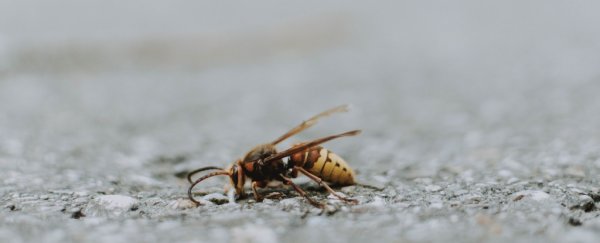The world's insects are in trouble. In recent years, growing evidence has found a scary number of bugs are missing from the face of our planet. And there's a chance we may have underestimated the scale of the problem.
In a large-scale biodiversity study, an international team of researchers has found insect species in the forests and grasslands of Germany have decreased by roughly a third. And that's just in the past decade.
"A decline on that scale over a period of just 10 years came as a complete surprise to us," says terrestrial ecologist Wolfgang Weisser from the Technical University of Munich (TUM).
"It is frightening, but fits the picture presented in a growing number of studies."
Between 2008 and 2017, the international team of researchers collected more than a million insects at 300 sites around Germany. Of the nearly 2,700 species investigated, many appear to be in decline. In fact, the team says in more recent years, some rare insects couldn't be found at all.
No matter where the researchers looked, the conclusion was the same. From sheep pastures to meadows to forests, the team reported significant losses in insect diversity, and the greatest disappearances came from grasslands, especially those surrounded by farms.
In this type of environment, the abundance of insects declined by 78 percent, while the biomass plummeted by 67 percent.
The loss of insects in German meadows has been demonstrated before, but never in such detail. Most previous studies focused only on biomass, which is the total weight of all insects, not on the sheer number of species present.
"The fact that a large part of all insect groups is actually affected has not been clear so far," says terrestrial ecologist Sebastian Seibold from TUM.
"Before our survey, it was unclear whether and to what extent forests were affected by the insect decline as well," he adds.
In the forested areas, biomass decreased by 40 percent and the number of species decreased by just over a third. The ones that suffered the most, the team says, were those insects that covered long distances. While this might be due to fractured forests, more research will be needed to determine the cause.
"Our results show that there are widespread declines in arthropod biomass, abundance and the number of species across trophic levels," the authors write.
"Arthropod declines in forests demonstrate that loss is not restricted to open habitats."
Further research will need to be done to gain a comprehensive picture of these changes in biomass, abundance, and diversity - but there are some clues in the data. The losses in German grasslands were highest among the rarest insects, and this could be what's mainly driving the shocking numbers.
In forests, on the other hand, there's a different story unfolding. Here, insect biomass remained relatively constant across 10 years; in fact, the most abundant insects became even more ubiquitous. This suggests that when insects disappear in forest environments, they are rapidly replaced by other, more opportunistic species.
Under the most catastrophic scenario, some scientists have warned insects could vanish within a century; others think it's more probable that a small number of species will survive by taking advantage of the loss of competitors.
While the authors did account for changes in weather, changes in climate were beyond the scope of this study. Not everyone is convinced that climate change is the global driver of insect loss, but there's reason to suspect it might contribute. If it does, it's bound to cause even more chaos.
"Although the drivers of arthropod decline in forests remain unclear, in grasslands these drivers are associated with the proportion of agricultural land in the landscape," the team explains.
"However, we cannot ascertain whether the observed declines are driven by the legacy effects of historical land-use intensification or by recent agricultural intensification at the landscape level."
Knowing what we know now, the authors are calling for a paradigm shift in land-use policy at a national and international level. They argue the best strategies should aim to improve habitat quality and mitigate the negative impact of current land-use practices, such as pesticides and isolated patches of nature surrounded by farms.
Saving these tiny creatures will likely require big changes.
The study was published in Nature.
